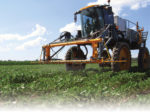Advertise Follow Us
Articles Tagged with ''nutrient''
Get The Most From Foliar Feeding Corn And Soybeans
Enhancing the nutrient efficiency of plants through the leaves is not only possible, but profitable, with the right level of management.
Read More
Gypsum Balances Nutrients, Builds Up Soil Structure
Proper applications of gypsum, an efficient carrier of soluble calcium, can help no-tillers improve the soil environment for plants and reclaim problematic sodic soils.
Read More
Increasing Crop Yields, While Reducing The Footprint
A focus on soil testing, timely nutrient application and precision technology are key efficient, effective practices for these nutrient-management stewards.
Read More
Finding The Fertility ‘Gold Mine’ After A Dry Year
No-tillers could save inputs costs and raise yields by accessing residual nutrients in fields, but they need relevant data and must understand the factors that affect nutrient availability.
Read More
Double-Digit Yield Boosts Seen With Fertilizer Additive
With prices higher than ever, corn and soybeans are meriting more top-end yield-producing products and fertility management.
Read More








